Project Execution Planning and Management
VerifiedAdded on 2023/06/08
|18
|3547
|480
AI Summary
This project aims to identify and accomplish the application of the project execution and management. It evaluates the importance of the project delivery method, financial contract type, procurement method, designing a risk management plan, and designing a quality management plan. The project focuses on Watpac Company, a leading company for construction and mining contracting business in Australia. It inspects how the company has been constructing various buildings in the country and how the company’s project succeeded in expanding the Adelaide Airport Terminal Expansion project.
Contribute Materials
Your contribution can guide someone’s learning journey. Share your
documents today.
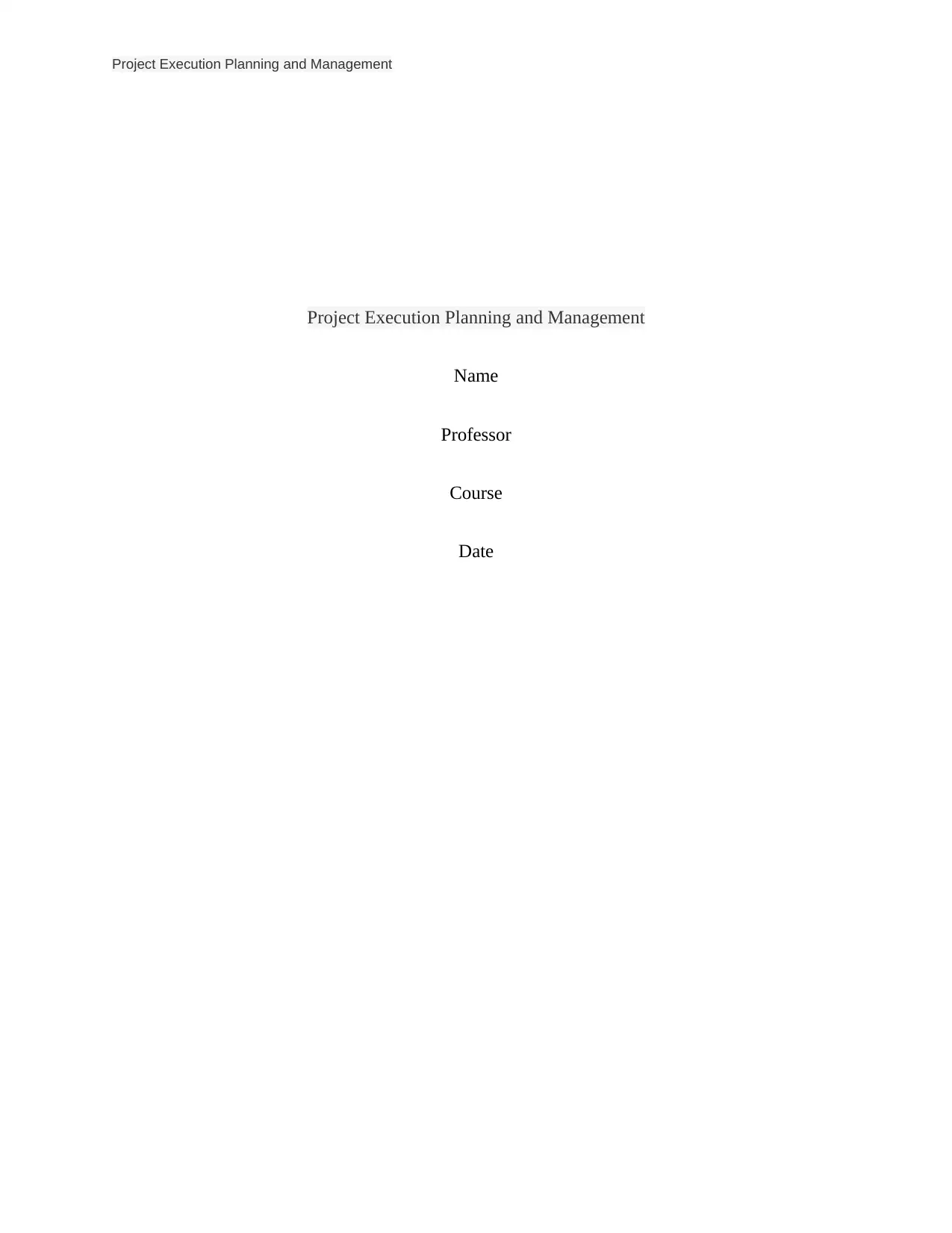
Project Execution Planning and Management
Project Execution Planning and Management
Name
Professor
Course
Date
Project Execution Planning and Management
Name
Professor
Course
Date
Secure Best Marks with AI Grader
Need help grading? Try our AI Grader for instant feedback on your assignments.
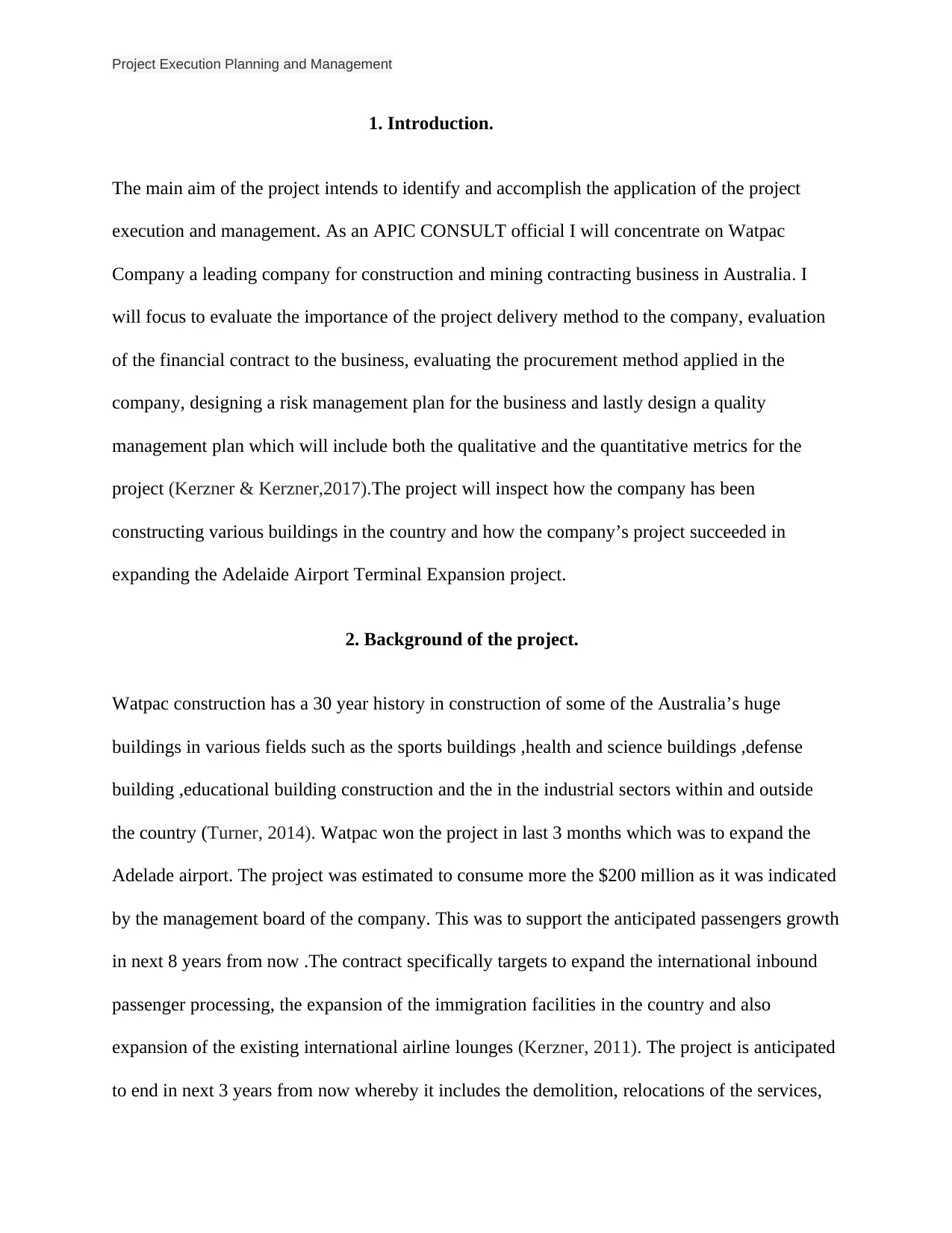
Project Execution Planning and Management
1. Introduction.
The main aim of the project intends to identify and accomplish the application of the project
execution and management. As an APIC CONSULT official I will concentrate on Watpac
Company a leading company for construction and mining contracting business in Australia. I
will focus to evaluate the importance of the project delivery method to the company, evaluation
of the financial contract to the business, evaluating the procurement method applied in the
company, designing a risk management plan for the business and lastly design a quality
management plan which will include both the qualitative and the quantitative metrics for the
project (Kerzner & Kerzner,2017).The project will inspect how the company has been
constructing various buildings in the country and how the company’s project succeeded in
expanding the Adelaide Airport Terminal Expansion project.
2. Background of the project.
Watpac construction has a 30 year history in construction of some of the Australia’s huge
buildings in various fields such as the sports buildings ,health and science buildings ,defense
building ,educational building construction and the in the industrial sectors within and outside
the country (Turner, 2014). Watpac won the project in last 3 months which was to expand the
Adelade airport. The project was estimated to consume more the $200 million as it was indicated
by the management board of the company. This was to support the anticipated passengers growth
in next 8 years from now .The contract specifically targets to expand the international inbound
passenger processing, the expansion of the immigration facilities in the country and also
expansion of the existing international airline lounges (Kerzner, 2011). The project is anticipated
to end in next 3 years from now whereby it includes the demolition, relocations of the services,
1. Introduction.
The main aim of the project intends to identify and accomplish the application of the project
execution and management. As an APIC CONSULT official I will concentrate on Watpac
Company a leading company for construction and mining contracting business in Australia. I
will focus to evaluate the importance of the project delivery method to the company, evaluation
of the financial contract to the business, evaluating the procurement method applied in the
company, designing a risk management plan for the business and lastly design a quality
management plan which will include both the qualitative and the quantitative metrics for the
project (Kerzner & Kerzner,2017).The project will inspect how the company has been
constructing various buildings in the country and how the company’s project succeeded in
expanding the Adelaide Airport Terminal Expansion project.
2. Background of the project.
Watpac construction has a 30 year history in construction of some of the Australia’s huge
buildings in various fields such as the sports buildings ,health and science buildings ,defense
building ,educational building construction and the in the industrial sectors within and outside
the country (Turner, 2014). Watpac won the project in last 3 months which was to expand the
Adelade airport. The project was estimated to consume more the $200 million as it was indicated
by the management board of the company. This was to support the anticipated passengers growth
in next 8 years from now .The contract specifically targets to expand the international inbound
passenger processing, the expansion of the immigration facilities in the country and also
expansion of the existing international airline lounges (Kerzner, 2011). The project is anticipated
to end in next 3 years from now whereby it includes the demolition, relocations of the services,
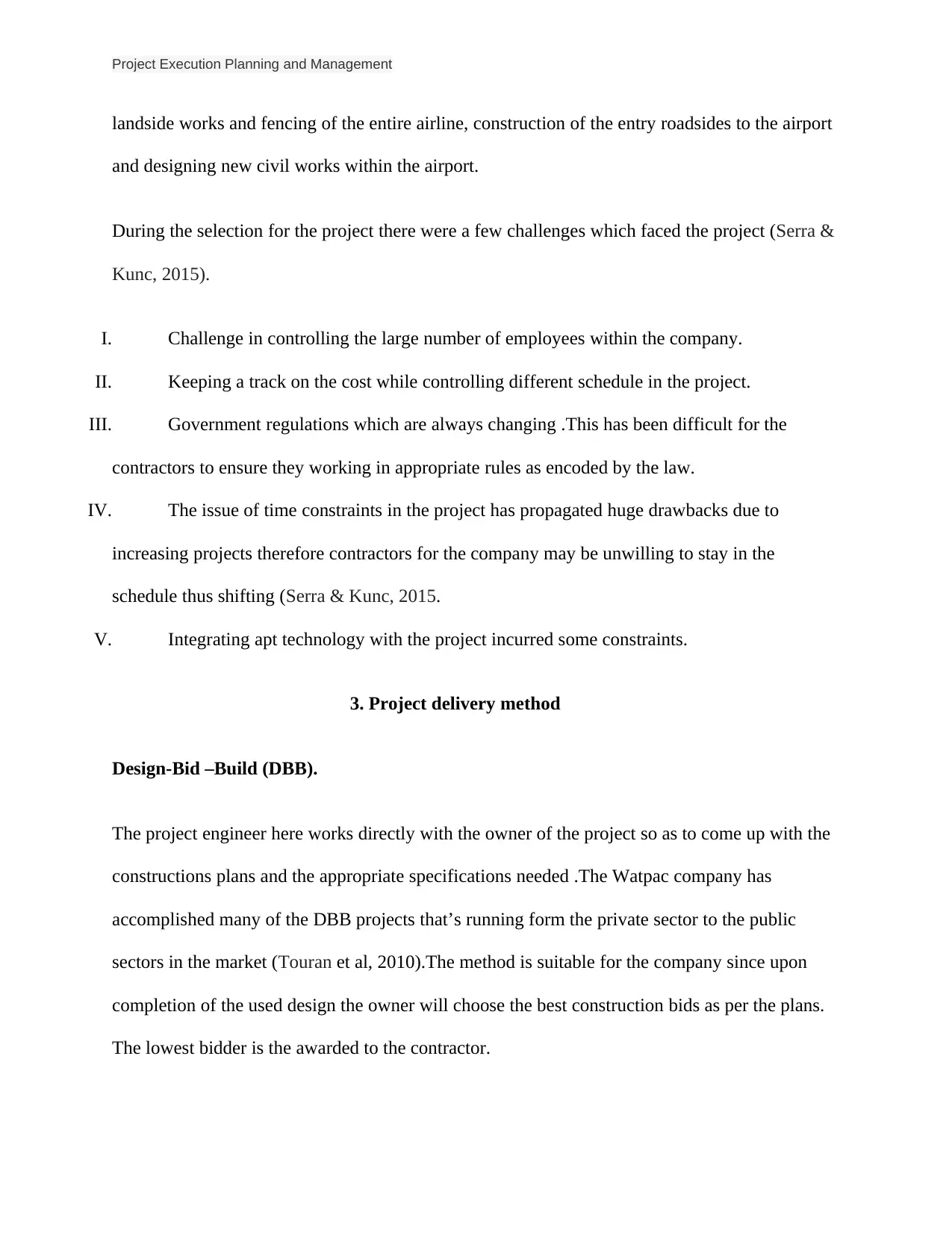
Project Execution Planning and Management
landside works and fencing of the entire airline, construction of the entry roadsides to the airport
and designing new civil works within the airport.
During the selection for the project there were a few challenges which faced the project (Serra &
Kunc, 2015).
I. Challenge in controlling the large number of employees within the company.
II. Keeping a track on the cost while controlling different schedule in the project.
III. Government regulations which are always changing .This has been difficult for the
contractors to ensure they working in appropriate rules as encoded by the law.
IV. The issue of time constraints in the project has propagated huge drawbacks due to
increasing projects therefore contractors for the company may be unwilling to stay in the
schedule thus shifting (Serra & Kunc, 2015.
V. Integrating apt technology with the project incurred some constraints.
3. Project delivery method
Design-Bid –Build (DBB).
The project engineer here works directly with the owner of the project so as to come up with the
constructions plans and the appropriate specifications needed .The Watpac company has
accomplished many of the DBB projects that’s running form the private sector to the public
sectors in the market (Touran et al, 2010).The method is suitable for the company since upon
completion of the used design the owner will choose the best construction bids as per the plans.
The lowest bidder is the awarded to the contractor.
landside works and fencing of the entire airline, construction of the entry roadsides to the airport
and designing new civil works within the airport.
During the selection for the project there were a few challenges which faced the project (Serra &
Kunc, 2015).
I. Challenge in controlling the large number of employees within the company.
II. Keeping a track on the cost while controlling different schedule in the project.
III. Government regulations which are always changing .This has been difficult for the
contractors to ensure they working in appropriate rules as encoded by the law.
IV. The issue of time constraints in the project has propagated huge drawbacks due to
increasing projects therefore contractors for the company may be unwilling to stay in the
schedule thus shifting (Serra & Kunc, 2015.
V. Integrating apt technology with the project incurred some constraints.
3. Project delivery method
Design-Bid –Build (DBB).
The project engineer here works directly with the owner of the project so as to come up with the
constructions plans and the appropriate specifications needed .The Watpac company has
accomplished many of the DBB projects that’s running form the private sector to the public
sectors in the market (Touran et al, 2010).The method is suitable for the company since upon
completion of the used design the owner will choose the best construction bids as per the plans.
The lowest bidder is the awarded to the contractor.
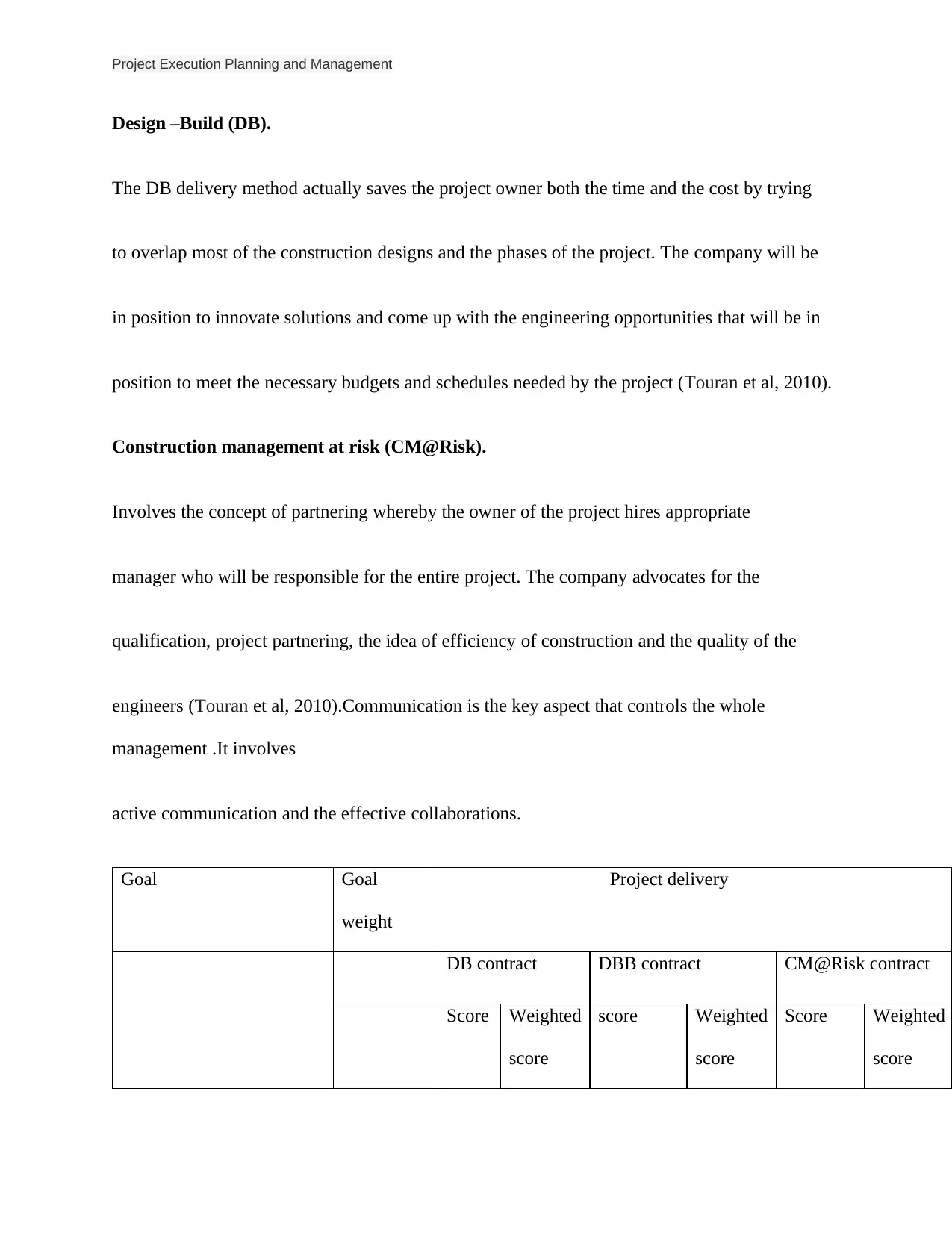
Project Execution Planning and Management
Design –Build (DB).
The DB delivery method actually saves the project owner both the time and the cost by trying
to overlap most of the construction designs and the phases of the project. The company will be
in position to innovate solutions and come up with the engineering opportunities that will be in
position to meet the necessary budgets and schedules needed by the project (Touran et al, 2010).
Construction management at risk (CM@Risk).
Involves the concept of partnering whereby the owner of the project hires appropriate
manager who will be responsible for the entire project. The company advocates for the
qualification, project partnering, the idea of efficiency of construction and the quality of the
engineers (Touran et al, 2010).Communication is the key aspect that controls the whole
management .It involves
active communication and the effective collaborations.
Goal Goal
weight
Project delivery
DB contract DBB contract CM@Risk contract
Score Weighted
score
score Weighted
score
Score Weighted
score
Design –Build (DB).
The DB delivery method actually saves the project owner both the time and the cost by trying
to overlap most of the construction designs and the phases of the project. The company will be
in position to innovate solutions and come up with the engineering opportunities that will be in
position to meet the necessary budgets and schedules needed by the project (Touran et al, 2010).
Construction management at risk (CM@Risk).
Involves the concept of partnering whereby the owner of the project hires appropriate
manager who will be responsible for the entire project. The company advocates for the
qualification, project partnering, the idea of efficiency of construction and the quality of the
engineers (Touran et al, 2010).Communication is the key aspect that controls the whole
management .It involves
active communication and the effective collaborations.
Goal Goal
weight
Project delivery
DB contract DBB contract CM@Risk contract
Score Weighted
score
score Weighted
score
Score Weighted
score
Secure Best Marks with AI Grader
Need help grading? Try our AI Grader for instant feedback on your assignments.
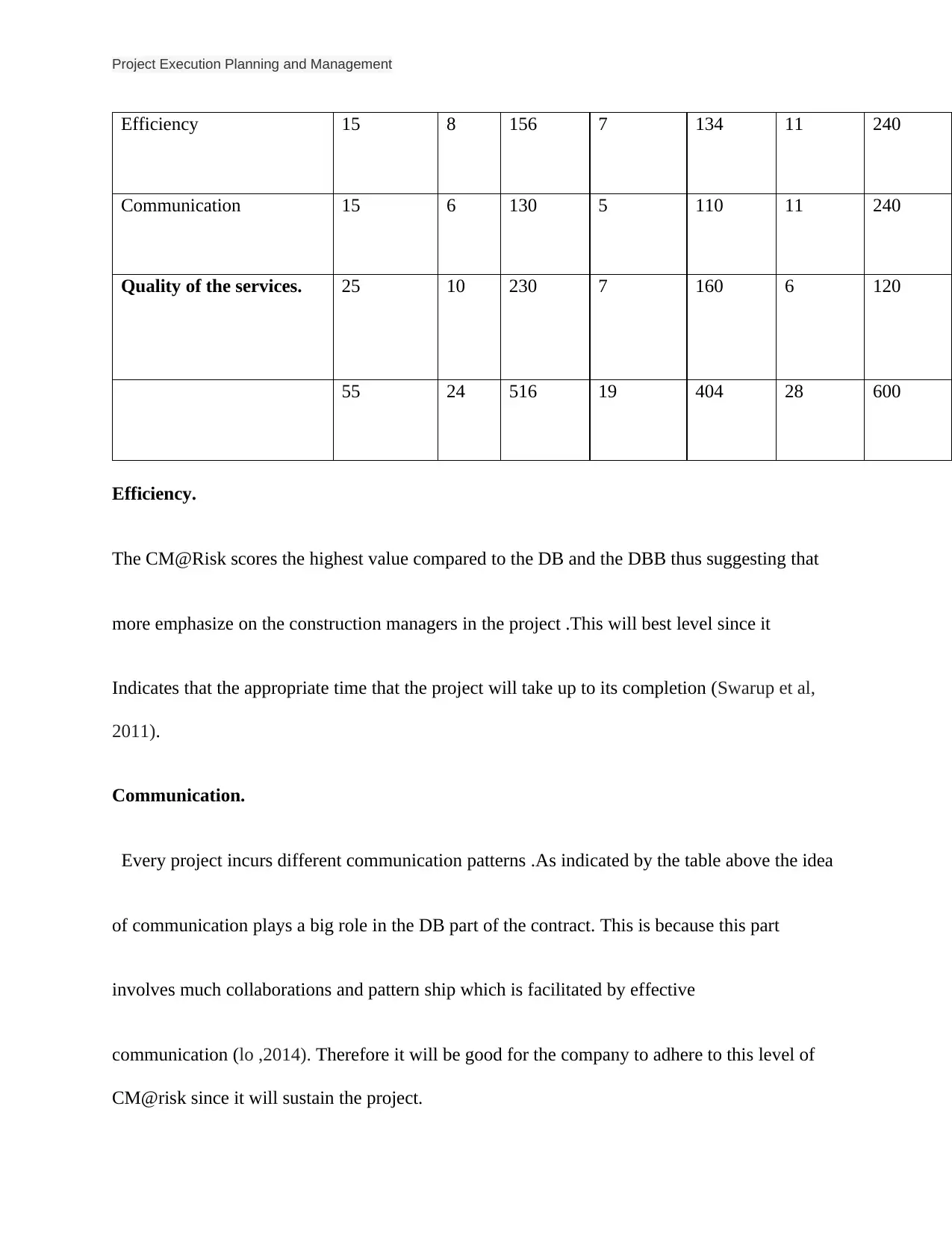
Project Execution Planning and Management
Efficiency 15 8 156 7 134 11 240
Communication 15 6 130 5 110 11 240
Quality of the services. 25 10 230 7 160 6 120
55 24 516 19 404 28 600
Efficiency.
The CM@Risk scores the highest value compared to the DB and the DBB thus suggesting that
more emphasize on the construction managers in the project .This will best level since it
Indicates that the appropriate time that the project will take up to its completion (Swarup et al,
2011).
Communication.
Every project incurs different communication patterns .As indicated by the table above the idea
of communication plays a big role in the DB part of the contract. This is because this part
involves much collaborations and pattern ship which is facilitated by effective
communication (lo ,2014). Therefore it will be good for the company to adhere to this level of
CM@risk since it will sustain the project.
Efficiency 15 8 156 7 134 11 240
Communication 15 6 130 5 110 11 240
Quality of the services. 25 10 230 7 160 6 120
55 24 516 19 404 28 600
Efficiency.
The CM@Risk scores the highest value compared to the DB and the DBB thus suggesting that
more emphasize on the construction managers in the project .This will best level since it
Indicates that the appropriate time that the project will take up to its completion (Swarup et al,
2011).
Communication.
Every project incurs different communication patterns .As indicated by the table above the idea
of communication plays a big role in the DB part of the contract. This is because this part
involves much collaborations and pattern ship which is facilitated by effective
communication (lo ,2014). Therefore it will be good for the company to adhere to this level of
CM@risk since it will sustain the project.
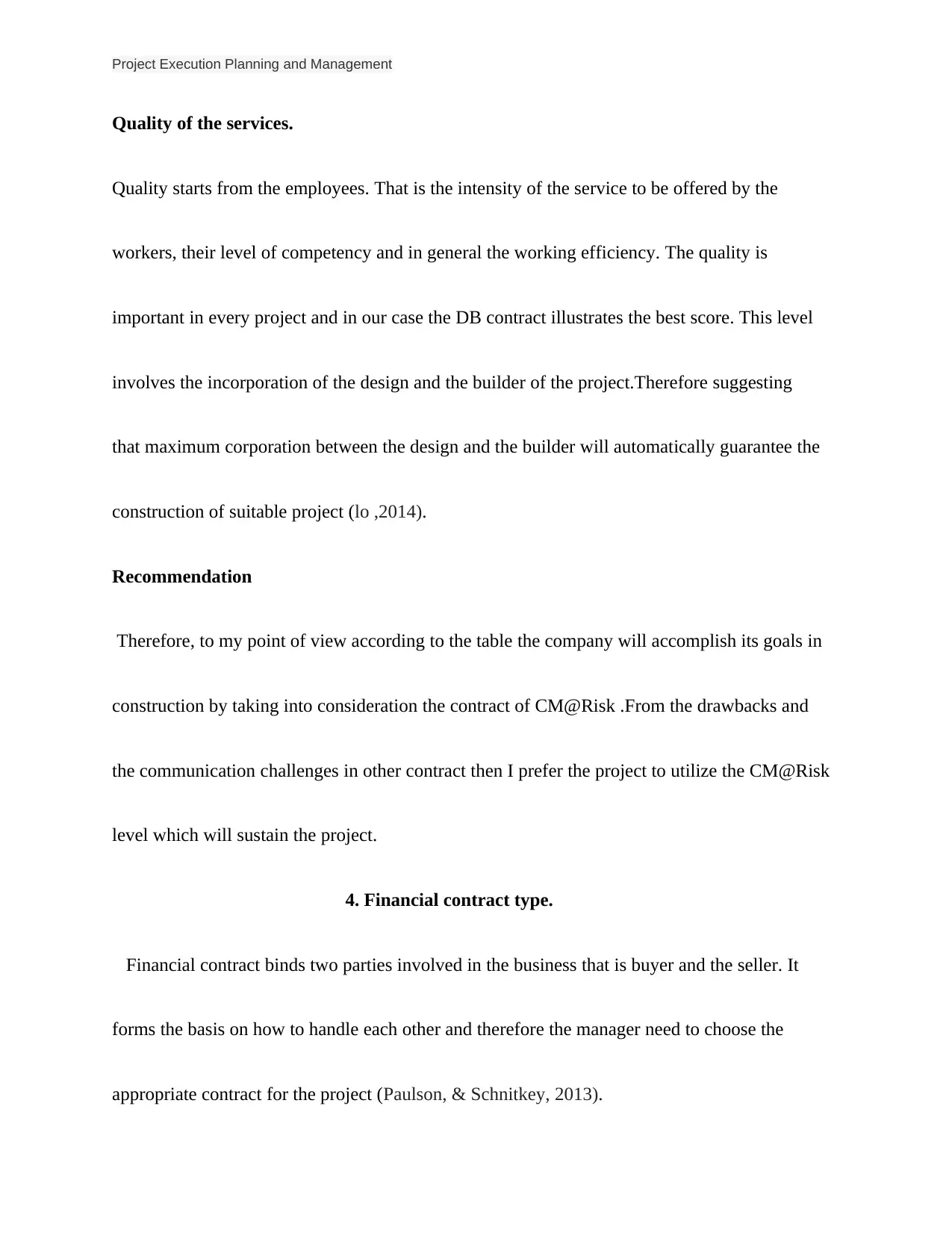
Project Execution Planning and Management
Quality of the services.
Quality starts from the employees. That is the intensity of the service to be offered by the
workers, their level of competency and in general the working efficiency. The quality is
important in every project and in our case the DB contract illustrates the best score. This level
involves the incorporation of the design and the builder of the project.Therefore suggesting
that maximum corporation between the design and the builder will automatically guarantee the
construction of suitable project (lo ,2014).
Recommendation
Therefore, to my point of view according to the table the company will accomplish its goals in
construction by taking into consideration the contract of CM@Risk .From the drawbacks and
the communication challenges in other contract then I prefer the project to utilize the CM@Risk
level which will sustain the project.
4. Financial contract type.
Financial contract binds two parties involved in the business that is buyer and the seller. It
forms the basis on how to handle each other and therefore the manager need to choose the
appropriate contract for the project (Paulson, & Schnitkey, 2013).
Quality of the services.
Quality starts from the employees. That is the intensity of the service to be offered by the
workers, their level of competency and in general the working efficiency. The quality is
important in every project and in our case the DB contract illustrates the best score. This level
involves the incorporation of the design and the builder of the project.Therefore suggesting
that maximum corporation between the design and the builder will automatically guarantee the
construction of suitable project (lo ,2014).
Recommendation
Therefore, to my point of view according to the table the company will accomplish its goals in
construction by taking into consideration the contract of CM@Risk .From the drawbacks and
the communication challenges in other contract then I prefer the project to utilize the CM@Risk
level which will sustain the project.
4. Financial contract type.
Financial contract binds two parties involved in the business that is buyer and the seller. It
forms the basis on how to handle each other and therefore the manager need to choose the
appropriate contract for the project (Paulson, & Schnitkey, 2013).

Project Execution Planning and Management
Lump sum contract.
The contract subjects the owner to pay the a contractor a lump sum of money immediately
the project is over. This is done without the cost breakdown meaning that after the completion
of the work no more measurement is required between the parties involved. This tends to be
suitable since the contractor of the company will estimate appropriate money needed for the
project as per agreement during the planning. The contractor charges the appropriate amount
as the requirement by the owner (Paulson, & Schnitkey, 2013).
Cost-Plus Fixed Fee Contract.
The contract level requires the owner to pay the contractor agreed amount as stipulated by
the documented cost of the project.
Guaranteed Maximum Price Contract (GMP).
The contractor of the project is compensated for the actual costs
that may be incurred during the project plus other fixed fee that may be a subject to the
ceiling price that may be incurred during the project. Here the contractor is accountable for the
cost overruns unless in some situations whereby the GMP is increased through the formal
order change of the project in the company (Paulson, & Schnitkey, 2013).
Lump sum contract.
The contract subjects the owner to pay the a contractor a lump sum of money immediately
the project is over. This is done without the cost breakdown meaning that after the completion
of the work no more measurement is required between the parties involved. This tends to be
suitable since the contractor of the company will estimate appropriate money needed for the
project as per agreement during the planning. The contractor charges the appropriate amount
as the requirement by the owner (Paulson, & Schnitkey, 2013).
Cost-Plus Fixed Fee Contract.
The contract level requires the owner to pay the contractor agreed amount as stipulated by
the documented cost of the project.
Guaranteed Maximum Price Contract (GMP).
The contractor of the project is compensated for the actual costs
that may be incurred during the project plus other fixed fee that may be a subject to the
ceiling price that may be incurred during the project. Here the contractor is accountable for the
cost overruns unless in some situations whereby the GMP is increased through the formal
order change of the project in the company (Paulson, & Schnitkey, 2013).
Paraphrase This Document
Need a fresh take? Get an instant paraphrase of this document with our AI Paraphraser
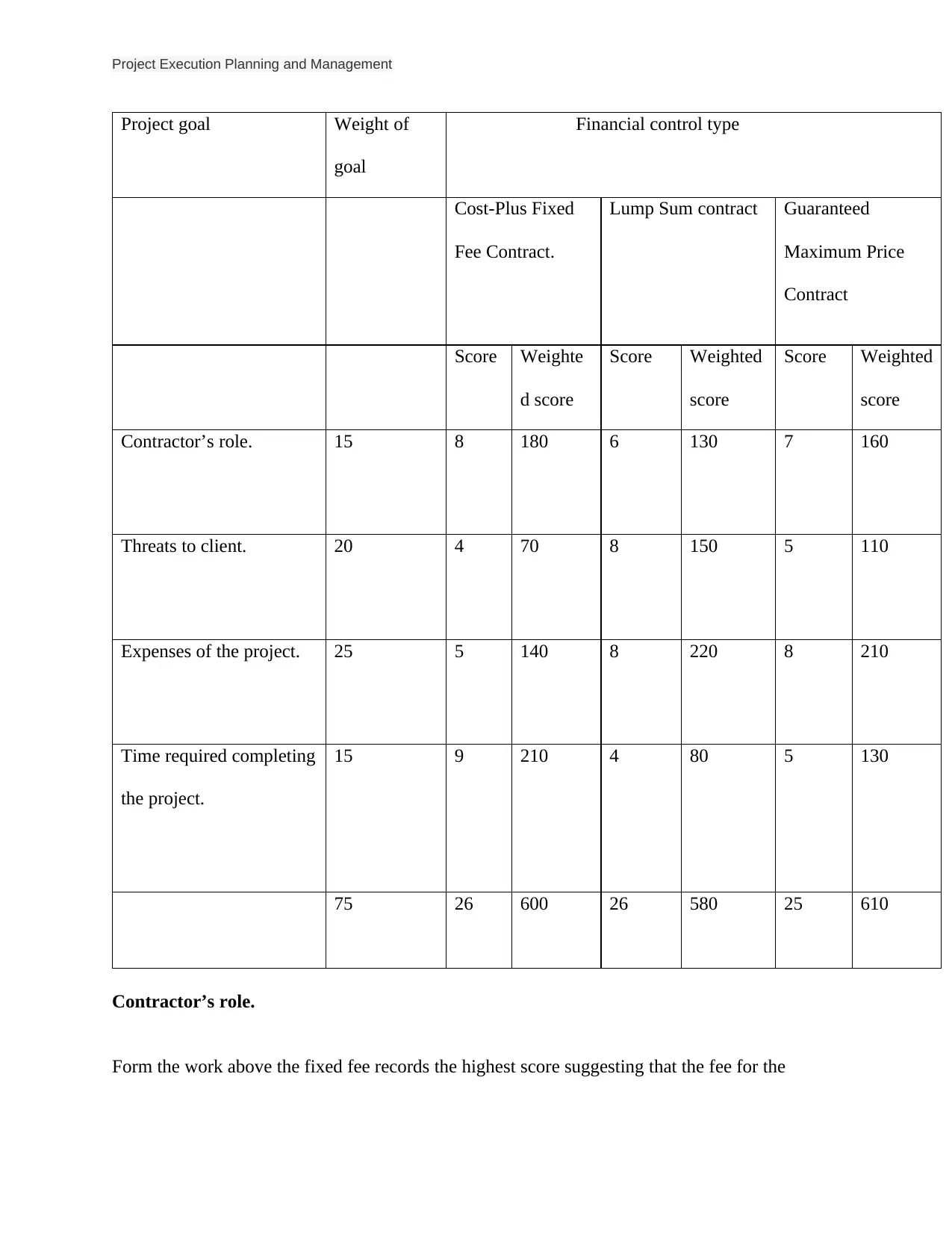
Project Execution Planning and Management
Project goal Weight of
goal
Financial control type
Cost-Plus Fixed
Fee Contract.
Lump Sum contract Guaranteed
Maximum Price
Contract
Score Weighte
d score
Score Weighted
score
Score Weighted
score
Contractor’s role. 15 8 180 6 130 7 160
Threats to client. 20 4 70 8 150 5 110
Expenses of the project. 25 5 140 8 220 8 210
Time required completing
the project.
15 9 210 4 80 5 130
75 26 600 26 580 25 610
Contractor’s role.
Form the work above the fixed fee records the highest score suggesting that the fee for the
Project goal Weight of
goal
Financial control type
Cost-Plus Fixed
Fee Contract.
Lump Sum contract Guaranteed
Maximum Price
Contract
Score Weighte
d score
Score Weighted
score
Score Weighted
score
Contractor’s role. 15 8 180 6 130 7 160
Threats to client. 20 4 70 8 150 5 110
Expenses of the project. 25 5 140 8 220 8 210
Time required completing
the project.
15 9 210 4 80 5 130
75 26 600 26 580 25 610
Contractor’s role.
Form the work above the fixed fee records the highest score suggesting that the fee for the
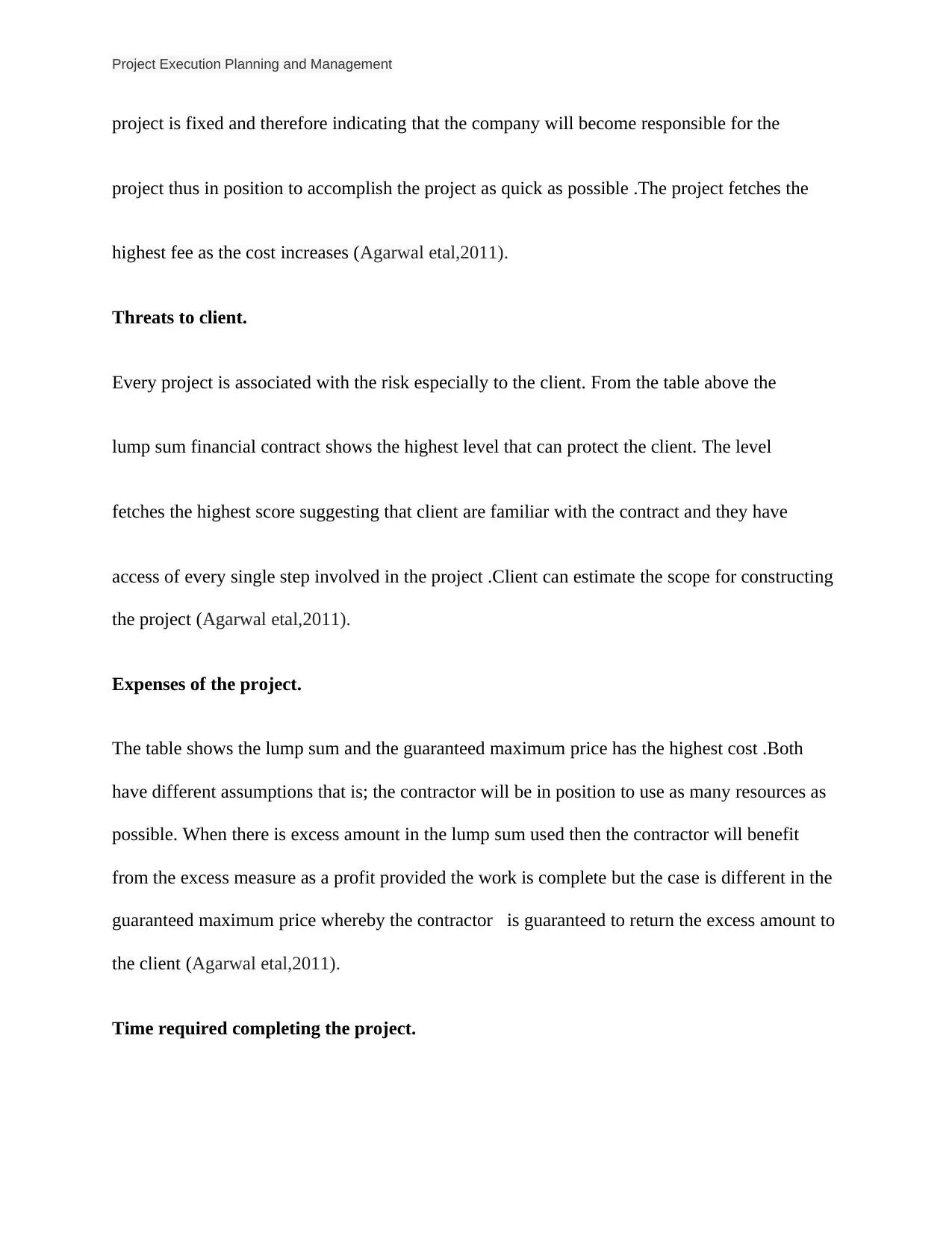
Project Execution Planning and Management
project is fixed and therefore indicating that the company will become responsible for the
project thus in position to accomplish the project as quick as possible .The project fetches the
highest fee as the cost increases (Agarwal etal,2011).
Threats to client.
Every project is associated with the risk especially to the client. From the table above the
lump sum financial contract shows the highest level that can protect the client. The level
fetches the highest score suggesting that client are familiar with the contract and they have
access of every single step involved in the project .Client can estimate the scope for constructing
the project (Agarwal etal,2011).
Expenses of the project.
The table shows the lump sum and the guaranteed maximum price has the highest cost .Both
have different assumptions that is; the contractor will be in position to use as many resources as
possible. When there is excess amount in the lump sum used then the contractor will benefit
from the excess measure as a profit provided the work is complete but the case is different in the
guaranteed maximum price whereby the contractor is guaranteed to return the excess amount to
the client (Agarwal etal,2011).
Time required completing the project.
project is fixed and therefore indicating that the company will become responsible for the
project thus in position to accomplish the project as quick as possible .The project fetches the
highest fee as the cost increases (Agarwal etal,2011).
Threats to client.
Every project is associated with the risk especially to the client. From the table above the
lump sum financial contract shows the highest level that can protect the client. The level
fetches the highest score suggesting that client are familiar with the contract and they have
access of every single step involved in the project .Client can estimate the scope for constructing
the project (Agarwal etal,2011).
Expenses of the project.
The table shows the lump sum and the guaranteed maximum price has the highest cost .Both
have different assumptions that is; the contractor will be in position to use as many resources as
possible. When there is excess amount in the lump sum used then the contractor will benefit
from the excess measure as a profit provided the work is complete but the case is different in the
guaranteed maximum price whereby the contractor is guaranteed to return the excess amount to
the client (Agarwal etal,2011).
Time required completing the project.
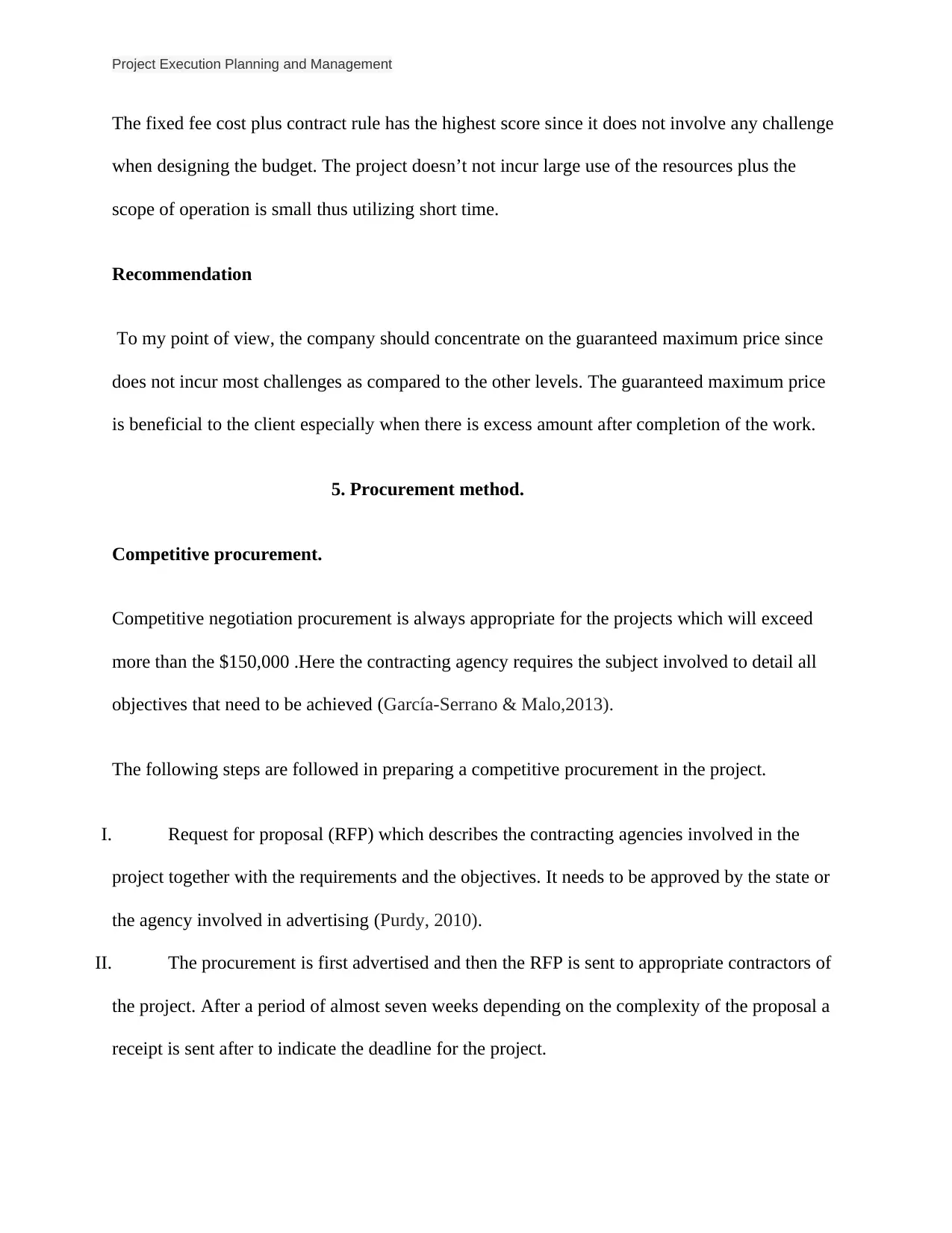
Project Execution Planning and Management
The fixed fee cost plus contract rule has the highest score since it does not involve any challenge
when designing the budget. The project doesn’t not incur large use of the resources plus the
scope of operation is small thus utilizing short time.
Recommendation
To my point of view, the company should concentrate on the guaranteed maximum price since
does not incur most challenges as compared to the other levels. The guaranteed maximum price
is beneficial to the client especially when there is excess amount after completion of the work.
5. Procurement method.
Competitive procurement.
Competitive negotiation procurement is always appropriate for the projects which will exceed
more than the $150,000 .Here the contracting agency requires the subject involved to detail all
objectives that need to be achieved (García-Serrano & Malo,2013).
The following steps are followed in preparing a competitive procurement in the project.
I. Request for proposal (RFP) which describes the contracting agencies involved in the
project together with the requirements and the objectives. It needs to be approved by the state or
the agency involved in advertising (Purdy, 2010).
II. The procurement is first advertised and then the RFP is sent to appropriate contractors of
the project. After a period of almost seven weeks depending on the complexity of the proposal a
receipt is sent after to indicate the deadline for the project.
The fixed fee cost plus contract rule has the highest score since it does not involve any challenge
when designing the budget. The project doesn’t not incur large use of the resources plus the
scope of operation is small thus utilizing short time.
Recommendation
To my point of view, the company should concentrate on the guaranteed maximum price since
does not incur most challenges as compared to the other levels. The guaranteed maximum price
is beneficial to the client especially when there is excess amount after completion of the work.
5. Procurement method.
Competitive procurement.
Competitive negotiation procurement is always appropriate for the projects which will exceed
more than the $150,000 .Here the contracting agency requires the subject involved to detail all
objectives that need to be achieved (García-Serrano & Malo,2013).
The following steps are followed in preparing a competitive procurement in the project.
I. Request for proposal (RFP) which describes the contracting agencies involved in the
project together with the requirements and the objectives. It needs to be approved by the state or
the agency involved in advertising (Purdy, 2010).
II. The procurement is first advertised and then the RFP is sent to appropriate contractors of
the project. After a period of almost seven weeks depending on the complexity of the proposal a
receipt is sent after to indicate the deadline for the project.
Secure Best Marks with AI Grader
Need help grading? Try our AI Grader for instant feedback on your assignments.
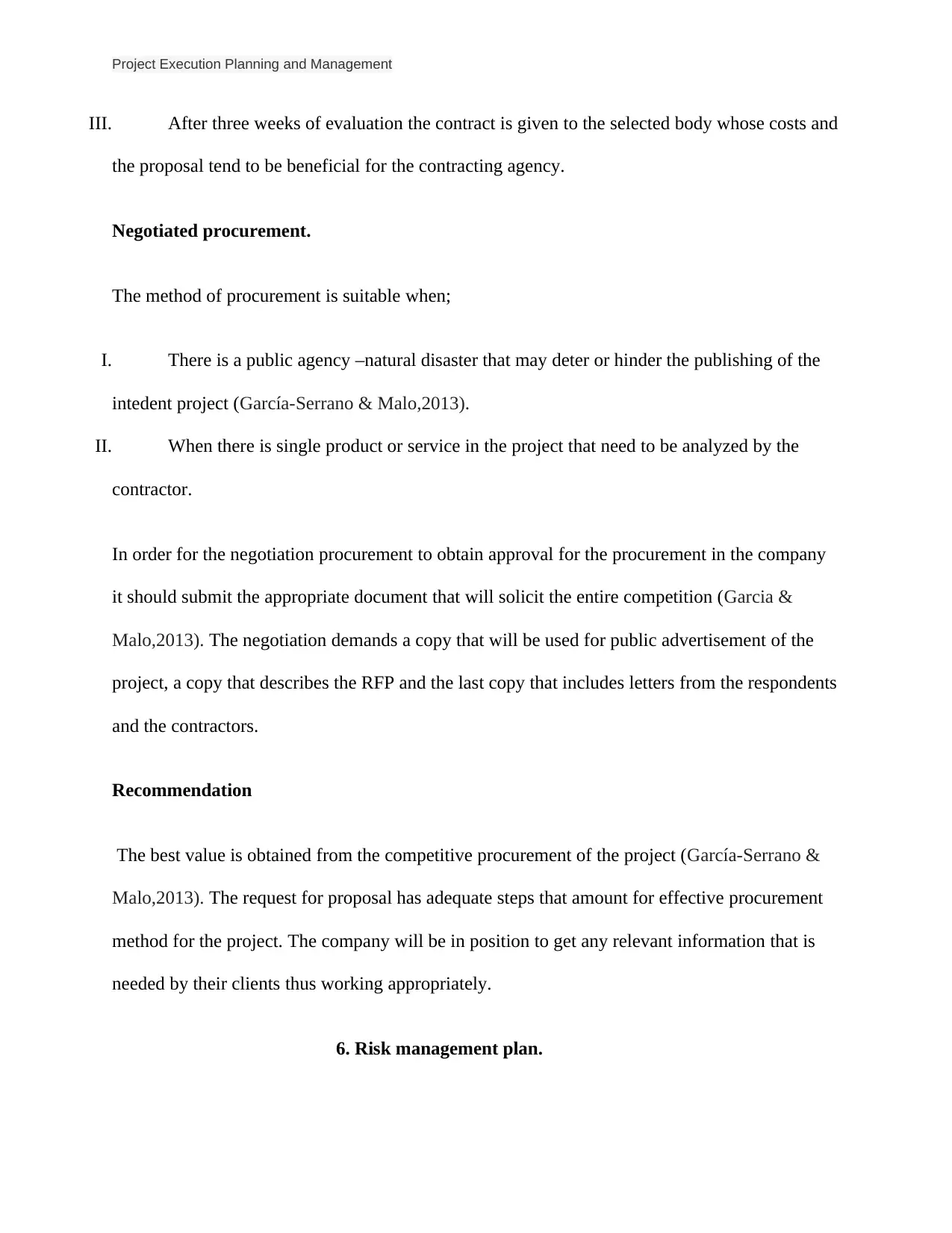
Project Execution Planning and Management
III. After three weeks of evaluation the contract is given to the selected body whose costs and
the proposal tend to be beneficial for the contracting agency.
Negotiated procurement.
The method of procurement is suitable when;
I. There is a public agency –natural disaster that may deter or hinder the publishing of the
intedent project (García-Serrano & Malo,2013).
II. When there is single product or service in the project that need to be analyzed by the
contractor.
In order for the negotiation procurement to obtain approval for the procurement in the company
it should submit the appropriate document that will solicit the entire competition (Garcia &
Malo,2013). The negotiation demands a copy that will be used for public advertisement of the
project, a copy that describes the RFP and the last copy that includes letters from the respondents
and the contractors.
Recommendation
The best value is obtained from the competitive procurement of the project (García-Serrano &
Malo,2013). The request for proposal has adequate steps that amount for effective procurement
method for the project. The company will be in position to get any relevant information that is
needed by their clients thus working appropriately.
6. Risk management plan.
III. After three weeks of evaluation the contract is given to the selected body whose costs and
the proposal tend to be beneficial for the contracting agency.
Negotiated procurement.
The method of procurement is suitable when;
I. There is a public agency –natural disaster that may deter or hinder the publishing of the
intedent project (García-Serrano & Malo,2013).
II. When there is single product or service in the project that need to be analyzed by the
contractor.
In order for the negotiation procurement to obtain approval for the procurement in the company
it should submit the appropriate document that will solicit the entire competition (Garcia &
Malo,2013). The negotiation demands a copy that will be used for public advertisement of the
project, a copy that describes the RFP and the last copy that includes letters from the respondents
and the contractors.
Recommendation
The best value is obtained from the competitive procurement of the project (García-Serrano &
Malo,2013). The request for proposal has adequate steps that amount for effective procurement
method for the project. The company will be in position to get any relevant information that is
needed by their clients thus working appropriately.
6. Risk management plan.
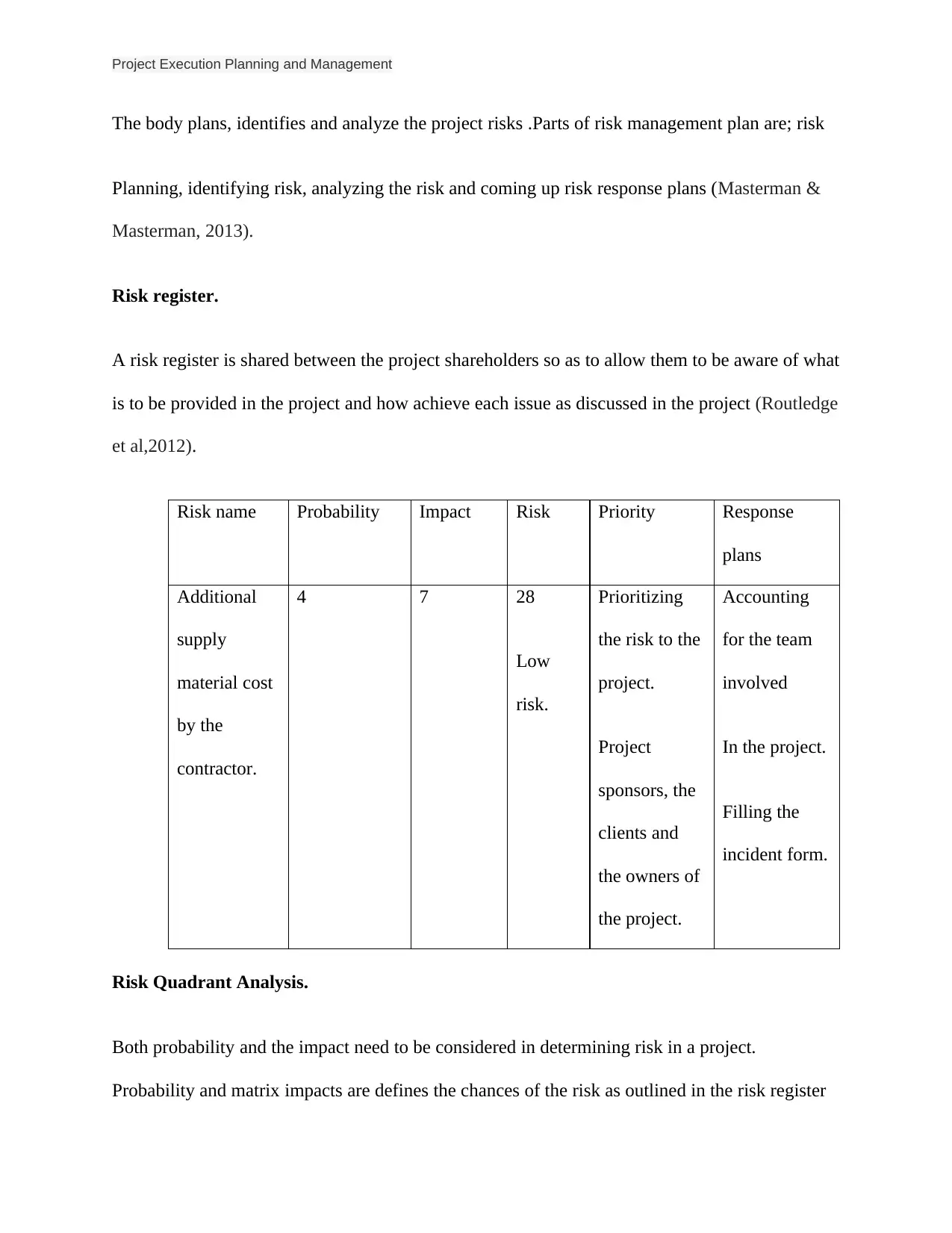
Project Execution Planning and Management
The body plans, identifies and analyze the project risks .Parts of risk management plan are; risk
Planning, identifying risk, analyzing the risk and coming up risk response plans (Masterman &
Masterman, 2013).
Risk register.
A risk register is shared between the project shareholders so as to allow them to be aware of what
is to be provided in the project and how achieve each issue as discussed in the project (Routledge
et al,2012).
Risk name Probability Impact Risk Priority Response
plans
Additional
supply
material cost
by the
contractor.
4 7 28
Low
risk.
Prioritizing
the risk to the
project.
Project
sponsors, the
clients and
the owners of
the project.
Accounting
for the team
involved
In the project.
Filling the
incident form.
Risk Quadrant Analysis.
Both probability and the impact need to be considered in determining risk in a project.
Probability and matrix impacts are defines the chances of the risk as outlined in the risk register
The body plans, identifies and analyze the project risks .Parts of risk management plan are; risk
Planning, identifying risk, analyzing the risk and coming up risk response plans (Masterman &
Masterman, 2013).
Risk register.
A risk register is shared between the project shareholders so as to allow them to be aware of what
is to be provided in the project and how achieve each issue as discussed in the project (Routledge
et al,2012).
Risk name Probability Impact Risk Priority Response
plans
Additional
supply
material cost
by the
contractor.
4 7 28
Low
risk.
Prioritizing
the risk to the
project.
Project
sponsors, the
clients and
the owners of
the project.
Accounting
for the team
involved
In the project.
Filling the
incident form.
Risk Quadrant Analysis.
Both probability and the impact need to be considered in determining risk in a project.
Probability and matrix impacts are defines the chances of the risk as outlined in the risk register
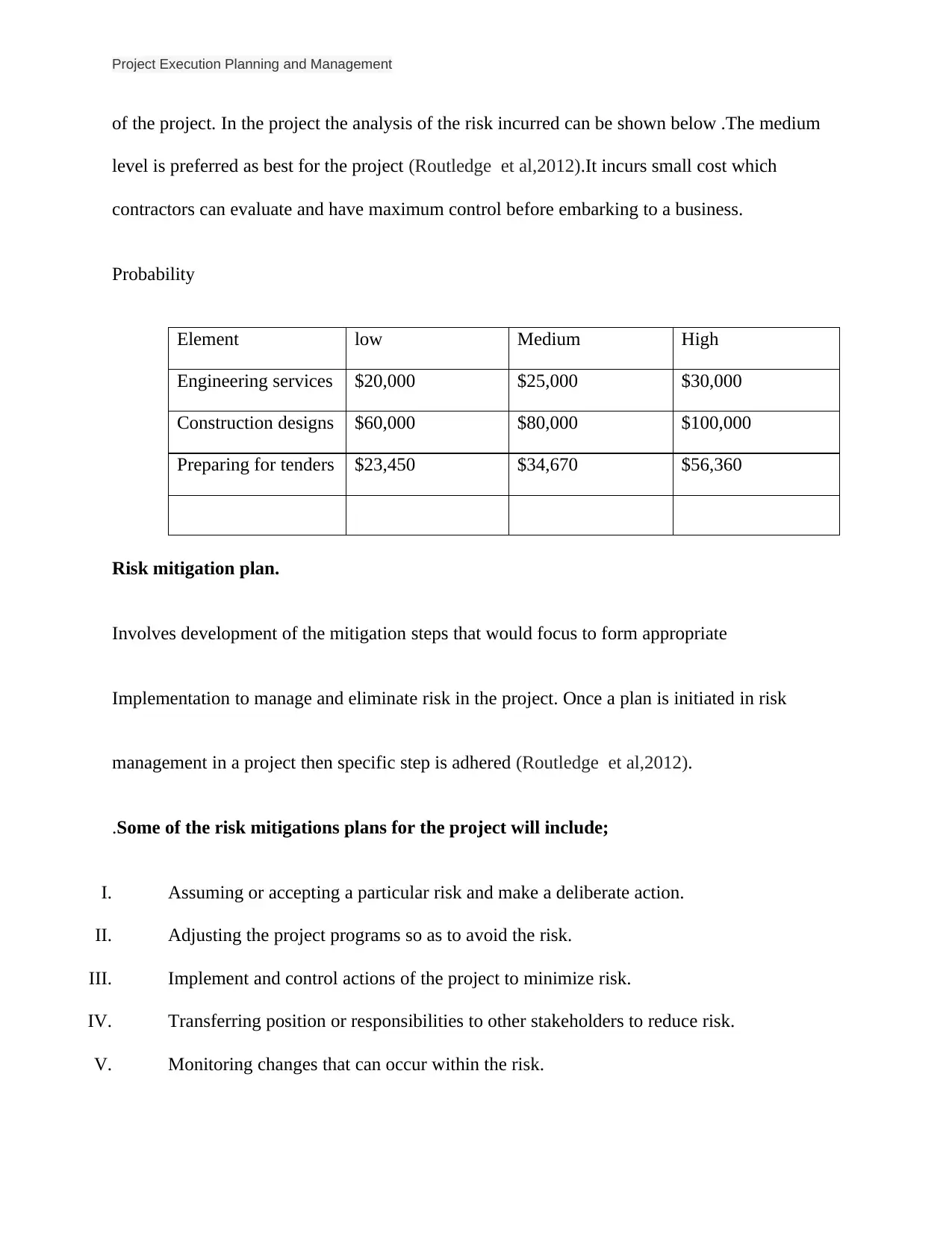
Project Execution Planning and Management
of the project. In the project the analysis of the risk incurred can be shown below .The medium
level is preferred as best for the project (Routledge et al,2012).It incurs small cost which
contractors can evaluate and have maximum control before embarking to a business.
Probability
Element low Medium High
Engineering services $20,000 $25,000 $30,000
Construction designs $60,000 $80,000 $100,000
Preparing for tenders $23,450 $34,670 $56,360
Risk mitigation plan.
Involves development of the mitigation steps that would focus to form appropriate
Implementation to manage and eliminate risk in the project. Once a plan is initiated in risk
management in a project then specific step is adhered (Routledge et al,2012).
.Some of the risk mitigations plans for the project will include;
I. Assuming or accepting a particular risk and make a deliberate action.
II. Adjusting the project programs so as to avoid the risk.
III. Implement and control actions of the project to minimize risk.
IV. Transferring position or responsibilities to other stakeholders to reduce risk.
V. Monitoring changes that can occur within the risk.
of the project. In the project the analysis of the risk incurred can be shown below .The medium
level is preferred as best for the project (Routledge et al,2012).It incurs small cost which
contractors can evaluate and have maximum control before embarking to a business.
Probability
Element low Medium High
Engineering services $20,000 $25,000 $30,000
Construction designs $60,000 $80,000 $100,000
Preparing for tenders $23,450 $34,670 $56,360
Risk mitigation plan.
Involves development of the mitigation steps that would focus to form appropriate
Implementation to manage and eliminate risk in the project. Once a plan is initiated in risk
management in a project then specific step is adhered (Routledge et al,2012).
.Some of the risk mitigations plans for the project will include;
I. Assuming or accepting a particular risk and make a deliberate action.
II. Adjusting the project programs so as to avoid the risk.
III. Implement and control actions of the project to minimize risk.
IV. Transferring position or responsibilities to other stakeholders to reduce risk.
V. Monitoring changes that can occur within the risk.
Paraphrase This Document
Need a fresh take? Get an instant paraphrase of this document with our AI Paraphraser
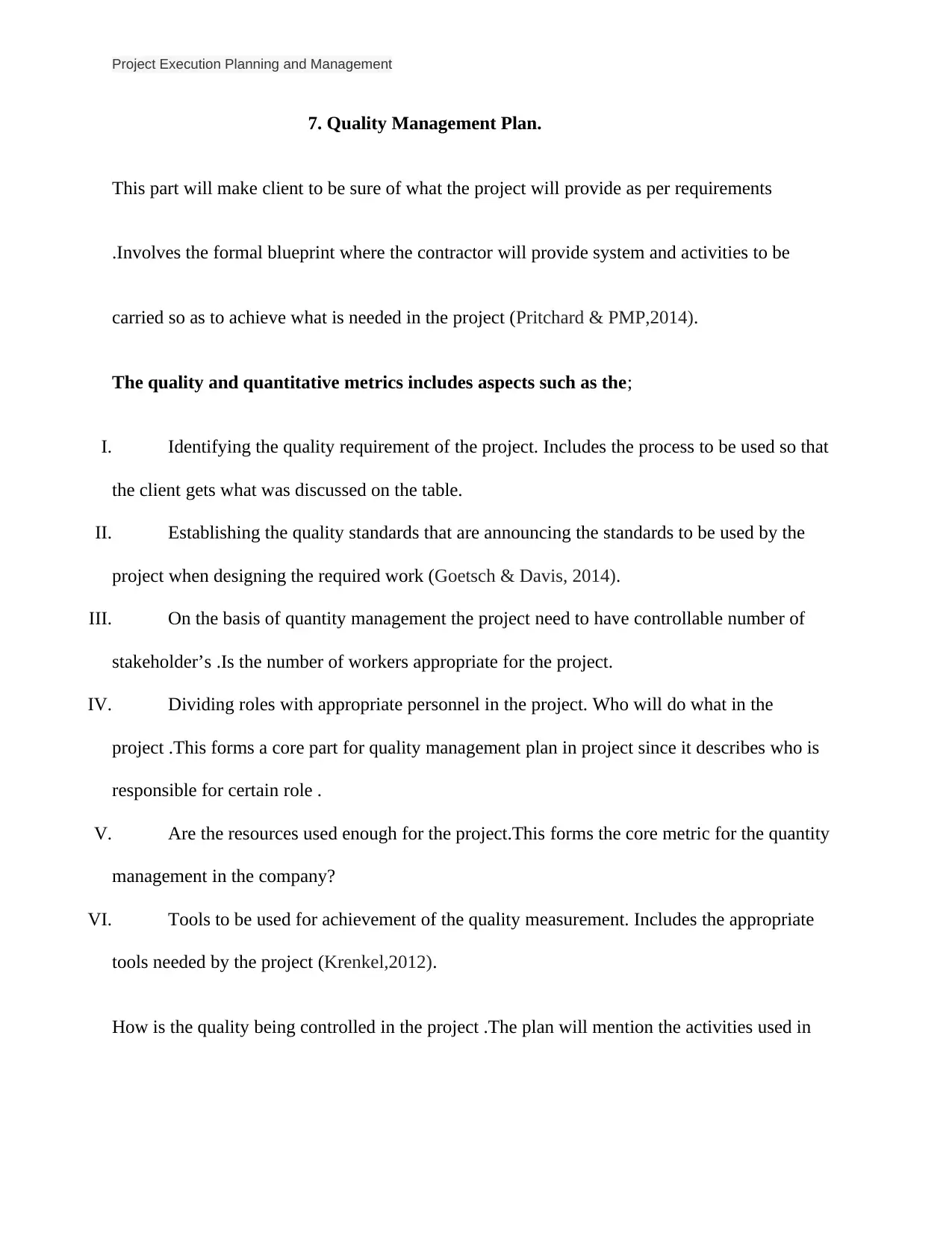
Project Execution Planning and Management
7. Quality Management Plan.
This part will make client to be sure of what the project will provide as per requirements
.Involves the formal blueprint where the contractor will provide system and activities to be
carried so as to achieve what is needed in the project (Pritchard & PMP,2014).
The quality and quantitative metrics includes aspects such as the;
I. Identifying the quality requirement of the project. Includes the process to be used so that
the client gets what was discussed on the table.
II. Establishing the quality standards that are announcing the standards to be used by the
project when designing the required work (Goetsch & Davis, 2014).
III. On the basis of quantity management the project need to have controllable number of
stakeholder’s .Is the number of workers appropriate for the project.
IV. Dividing roles with appropriate personnel in the project. Who will do what in the
project .This forms a core part for quality management plan in project since it describes who is
responsible for certain role .
V. Are the resources used enough for the project.This forms the core metric for the quantity
management in the company?
VI. Tools to be used for achievement of the quality measurement. Includes the appropriate
tools needed by the project (Krenkel,2012).
How is the quality being controlled in the project .The plan will mention the activities used in
7. Quality Management Plan.
This part will make client to be sure of what the project will provide as per requirements
.Involves the formal blueprint where the contractor will provide system and activities to be
carried so as to achieve what is needed in the project (Pritchard & PMP,2014).
The quality and quantitative metrics includes aspects such as the;
I. Identifying the quality requirement of the project. Includes the process to be used so that
the client gets what was discussed on the table.
II. Establishing the quality standards that are announcing the standards to be used by the
project when designing the required work (Goetsch & Davis, 2014).
III. On the basis of quantity management the project need to have controllable number of
stakeholder’s .Is the number of workers appropriate for the project.
IV. Dividing roles with appropriate personnel in the project. Who will do what in the
project .This forms a core part for quality management plan in project since it describes who is
responsible for certain role .
V. Are the resources used enough for the project.This forms the core metric for the quantity
management in the company?
VI. Tools to be used for achievement of the quality measurement. Includes the appropriate
tools needed by the project (Krenkel,2012).
How is the quality being controlled in the project .The plan will mention the activities used in
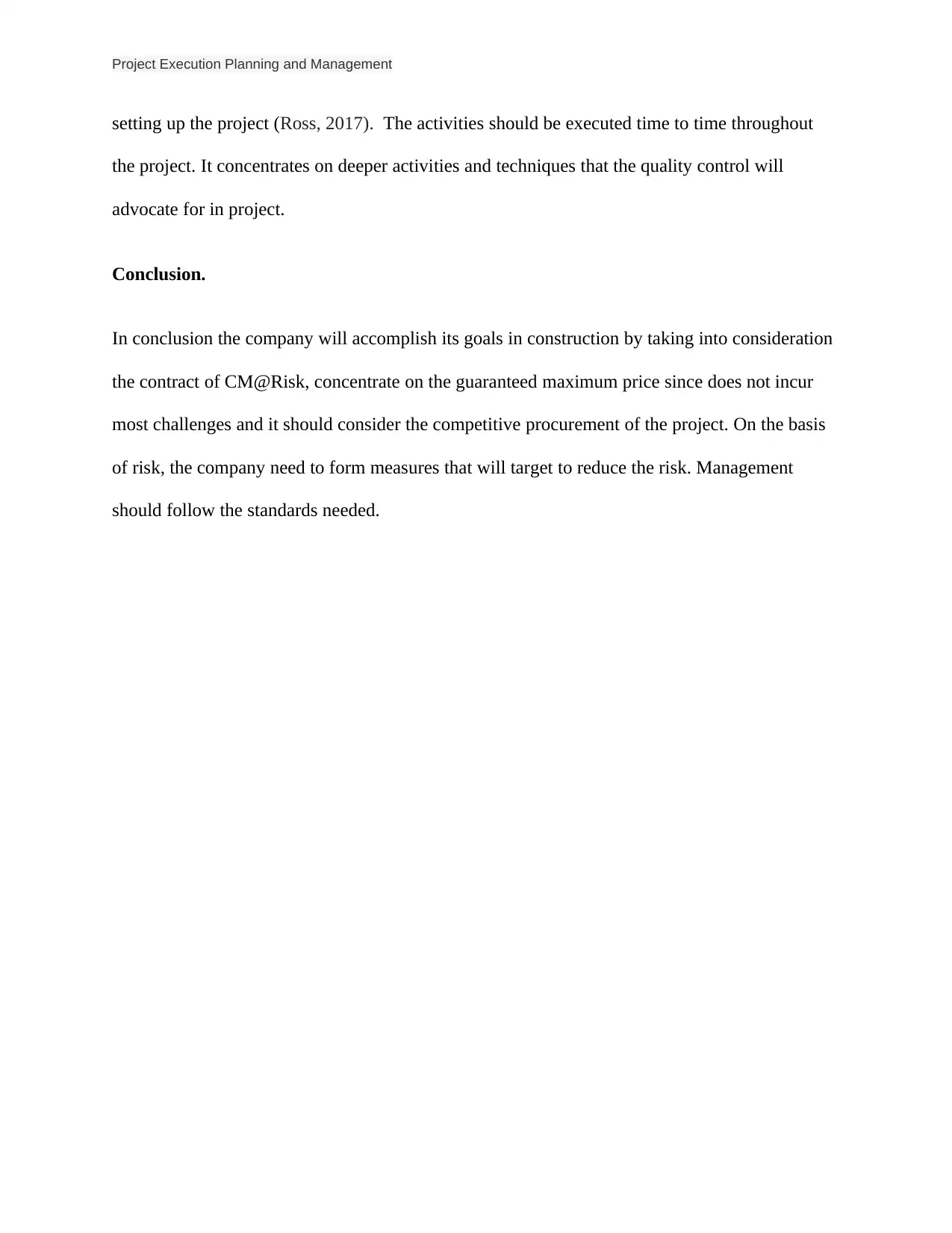
Project Execution Planning and Management
setting up the project (Ross, 2017). The activities should be executed time to time throughout
the project. It concentrates on deeper activities and techniques that the quality control will
advocate for in project.
Conclusion.
In conclusion the company will accomplish its goals in construction by taking into consideration
the contract of CM@Risk, concentrate on the guaranteed maximum price since does not incur
most challenges and it should consider the competitive procurement of the project. On the basis
of risk, the company need to form measures that will target to reduce the risk. Management
should follow the standards needed.
setting up the project (Ross, 2017). The activities should be executed time to time throughout
the project. It concentrates on deeper activities and techniques that the quality control will
advocate for in project.
Conclusion.
In conclusion the company will accomplish its goals in construction by taking into consideration
the contract of CM@Risk, concentrate on the guaranteed maximum price since does not incur
most challenges and it should consider the competitive procurement of the project. On the basis
of risk, the company need to form measures that will target to reduce the risk. Management
should follow the standards needed.
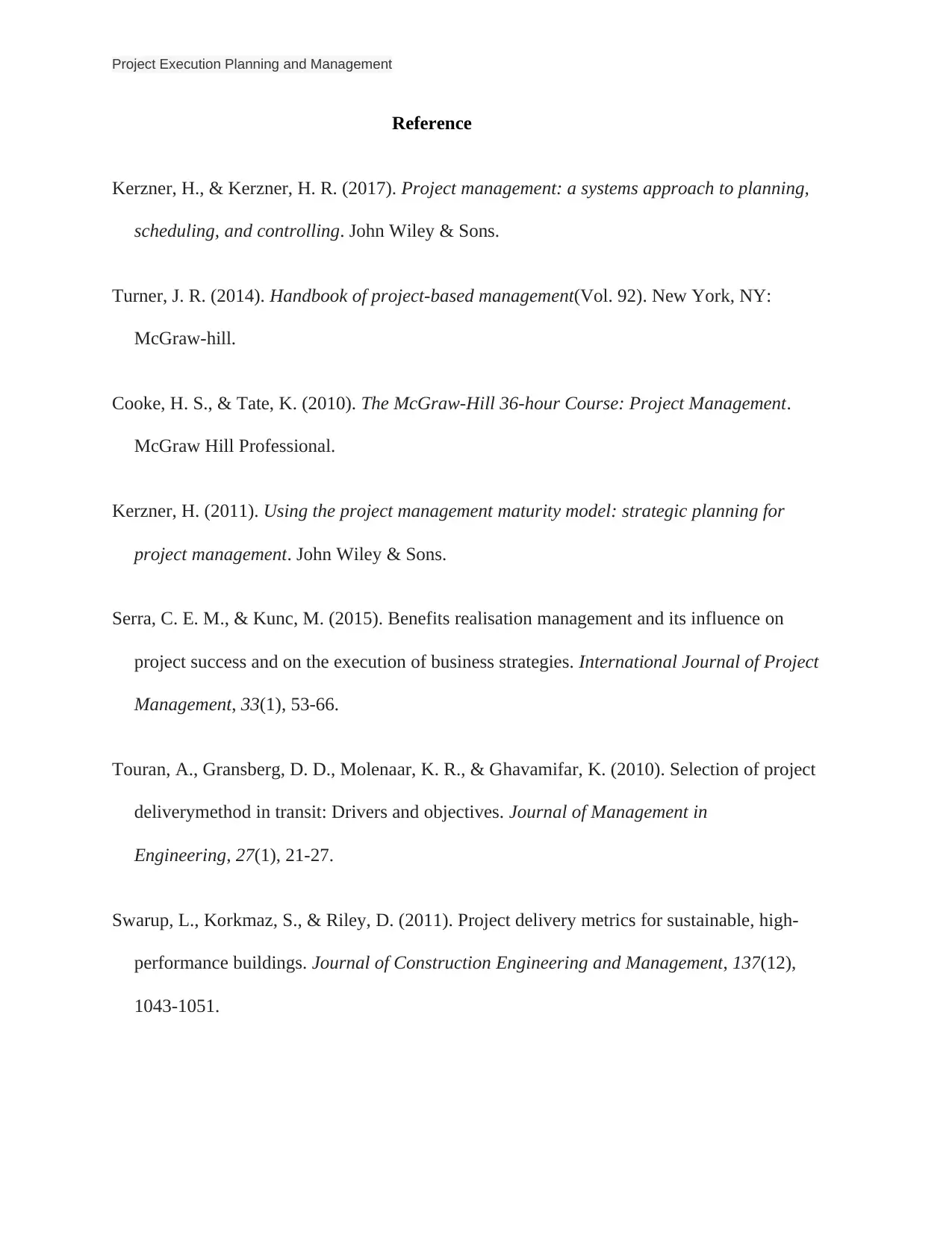
Project Execution Planning and Management
Reference
Kerzner, H., & Kerzner, H. R. (2017). Project management: a systems approach to planning,
scheduling, and controlling. John Wiley & Sons.
Turner, J. R. (2014). Handbook of project-based management(Vol. 92). New York, NY:
McGraw-hill.
Cooke, H. S., & Tate, K. (2010). The McGraw-Hill 36-hour Course: Project Management.
McGraw Hill Professional.
Kerzner, H. (2011). Using the project management maturity model: strategic planning for
project management. John Wiley & Sons.
Serra, C. E. M., & Kunc, M. (2015). Benefits realisation management and its influence on
project success and on the execution of business strategies. International Journal of Project
Management, 33(1), 53-66.
Touran, A., Gransberg, D. D., Molenaar, K. R., & Ghavamifar, K. (2010). Selection of project
deliverymethod in transit: Drivers and objectives. Journal of Management in
Engineering, 27(1), 21-27.
Swarup, L., Korkmaz, S., & Riley, D. (2011). Project delivery metrics for sustainable, high-
performance buildings. Journal of Construction Engineering and Management, 137(12),
1043-1051.
Reference
Kerzner, H., & Kerzner, H. R. (2017). Project management: a systems approach to planning,
scheduling, and controlling. John Wiley & Sons.
Turner, J. R. (2014). Handbook of project-based management(Vol. 92). New York, NY:
McGraw-hill.
Cooke, H. S., & Tate, K. (2010). The McGraw-Hill 36-hour Course: Project Management.
McGraw Hill Professional.
Kerzner, H. (2011). Using the project management maturity model: strategic planning for
project management. John Wiley & Sons.
Serra, C. E. M., & Kunc, M. (2015). Benefits realisation management and its influence on
project success and on the execution of business strategies. International Journal of Project
Management, 33(1), 53-66.
Touran, A., Gransberg, D. D., Molenaar, K. R., & Ghavamifar, K. (2010). Selection of project
deliverymethod in transit: Drivers and objectives. Journal of Management in
Engineering, 27(1), 21-27.
Swarup, L., Korkmaz, S., & Riley, D. (2011). Project delivery metrics for sustainable, high-
performance buildings. Journal of Construction Engineering and Management, 137(12),
1043-1051.
Secure Best Marks with AI Grader
Need help grading? Try our AI Grader for instant feedback on your assignments.
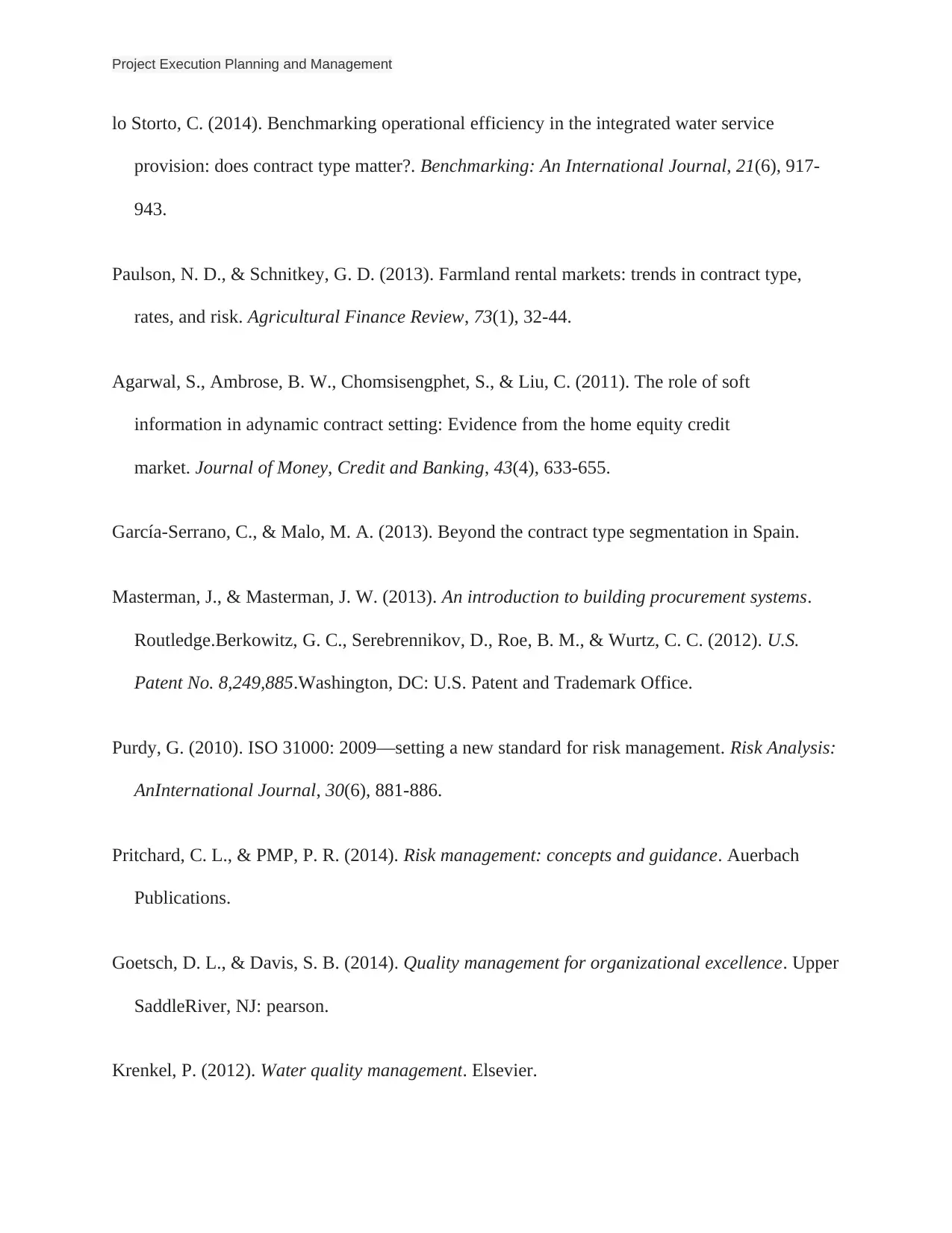
Project Execution Planning and Management
lo Storto, C. (2014). Benchmarking operational efficiency in the integrated water service
provision: does contract type matter?. Benchmarking: An International Journal, 21(6), 917-
943.
Paulson, N. D., & Schnitkey, G. D. (2013). Farmland rental markets: trends in contract type,
rates, and risk. Agricultural Finance Review, 73(1), 32-44.
Agarwal, S., Ambrose, B. W., Chomsisengphet, S., & Liu, C. (2011). The role of soft
information in adynamic contract setting: Evidence from the home equity credit
market. Journal of Money, Credit and Banking, 43(4), 633-655.
García-Serrano, C., & Malo, M. A. (2013). Beyond the contract type segmentation in Spain.
Masterman, J., & Masterman, J. W. (2013). An introduction to building procurement systems.
Routledge.Berkowitz, G. C., Serebrennikov, D., Roe, B. M., & Wurtz, C. C. (2012). U.S.
Patent No. 8,249,885.Washington, DC: U.S. Patent and Trademark Office.
Purdy, G. (2010). ISO 31000: 2009—setting a new standard for risk management. Risk Analysis:
AnInternational Journal, 30(6), 881-886.
Pritchard, C. L., & PMP, P. R. (2014). Risk management: concepts and guidance. Auerbach
Publications.
Goetsch, D. L., & Davis, S. B. (2014). Quality management for organizational excellence. Upper
SaddleRiver, NJ: pearson.
Krenkel, P. (2012). Water quality management. Elsevier.
lo Storto, C. (2014). Benchmarking operational efficiency in the integrated water service
provision: does contract type matter?. Benchmarking: An International Journal, 21(6), 917-
943.
Paulson, N. D., & Schnitkey, G. D. (2013). Farmland rental markets: trends in contract type,
rates, and risk. Agricultural Finance Review, 73(1), 32-44.
Agarwal, S., Ambrose, B. W., Chomsisengphet, S., & Liu, C. (2011). The role of soft
information in adynamic contract setting: Evidence from the home equity credit
market. Journal of Money, Credit and Banking, 43(4), 633-655.
García-Serrano, C., & Malo, M. A. (2013). Beyond the contract type segmentation in Spain.
Masterman, J., & Masterman, J. W. (2013). An introduction to building procurement systems.
Routledge.Berkowitz, G. C., Serebrennikov, D., Roe, B. M., & Wurtz, C. C. (2012). U.S.
Patent No. 8,249,885.Washington, DC: U.S. Patent and Trademark Office.
Purdy, G. (2010). ISO 31000: 2009—setting a new standard for risk management. Risk Analysis:
AnInternational Journal, 30(6), 881-886.
Pritchard, C. L., & PMP, P. R. (2014). Risk management: concepts and guidance. Auerbach
Publications.
Goetsch, D. L., & Davis, S. B. (2014). Quality management for organizational excellence. Upper
SaddleRiver, NJ: pearson.
Krenkel, P. (2012). Water quality management. Elsevier.

Project Execution Planning and Management
Ross, J. E. (2017). Total quality management: Text, cases, and readings. Routledge.
Ross, J. E. (2017). Total quality management: Text, cases, and readings. Routledge.
1 out of 18
Related Documents
Your All-in-One AI-Powered Toolkit for Academic Success.
+13062052269
info@desklib.com
Available 24*7 on WhatsApp / Email
![[object Object]](/_next/static/media/star-bottom.7253800d.svg)
Unlock your academic potential
© 2024 | Zucol Services PVT LTD | All rights reserved.




